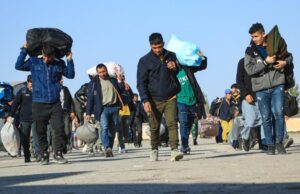KABUL (SW) – Findings of a survey conducted by Salam Watandar in Kabul city show an escalating trend of youth migrating out of the country through desperate measures.
Out of 312 surveyed families, the findings reveal that 238 families, comprising 76.5% reported their family members migrating, with the highest migration rates occurring in the past three years, particularly post-political upheavals in the country.
Similarly, among the 238 families with migrating members, when asked which family member had migrated, 61% reported that their young brothers had migrated, while 15% stated it was their sisters. Additionally, 5% of respondents said their husbands, 8% mentioned their children and 7% reported both their daughters and sons had migrated. Some 4% reported that their fathers had migrated.
Among the surveyed families, 77 individuals which constitute 31.8%, cited economic, security, and future hopelessness as reasons for their family members’ migration. 30.6% of them solely attributed economic issues, while 26% mentioned hopelessness about the future. Additionally, 11.6% highlighted security problems and threats as contributing factors.
In this survey conducted in Kabul city, among 312 families, participants were asked if they would migrate if the circumstances of migration are provided?
Salam Watandar continues to investigate the interest of families in migration. Out of the 312 respondents, 258 individuals, constituting 83%, expressed their willingness to leave the country for a better life and to escape the current problems in Afghanistan. Subsequently, only 17% stated they would stay and contribute to building the nation.
However, some youth who have returned to Afghanistan told Salam Watandar that, following the establishment of the Islamic Emirate in the country, they migrated to neighboring countries. However, due to “inhumane treatment and insults directed at migrants by host countries”, they returned to Afghanistan and resumed their education and work.
Shamsuddin Nabizada says: “We left Afghanistan for Iran, but even there, we were treated like commodities. From there, we went to Turkey, where the situation was even worse. Then we headed towards European countries. We attempted illegal crossings two or three times. In another country, we faced bad treatment; when they caught us, they stripped us of our clothes and everything we had and beaten us. They even shaved off my eyebrows. After that, I decided to return to my country, and now I am busy with my studies.”
Emal also says: “I was in Turkey for two years. I had money, but I did not have peace, and we were not treated properly. So, I returned to my country. It has been six months since I returned. I am busy with my job as a tailor.”
Sociologists warn that if attention is not paid to the youth and if they are not provided with political, economic, and social opportunities, especially in education and employment, the exodus of young people from the country will lead to a crisis worse than the current one, with dire consequences.
Zia Shams, a sociologist, states: “When a significant part of society migrates or has migrated, the community loses many of its essential forces, leaving behind those who remain in the community and harbor thoughts and motivations of leaving. Consequently, the community weakens, resembling either an aged or infantile society. Moreover, the community loses its skilled and professional workforce, disrupting and debilitating its future prospects.”
We attempted to obtain precise figures on the number of migrants from the Ministry of Repatriations and Refugees officials. However, despite repeated attempts, we did not succeed.
Although migration in Afghanistan is not a new phenomenon, it has increased significantly since the collapse of the Republic on August 15, 2021, to an unprecedented extent. Afghanistan has thus far accounted for the highest number of both legal and illegal migrations in the region.





